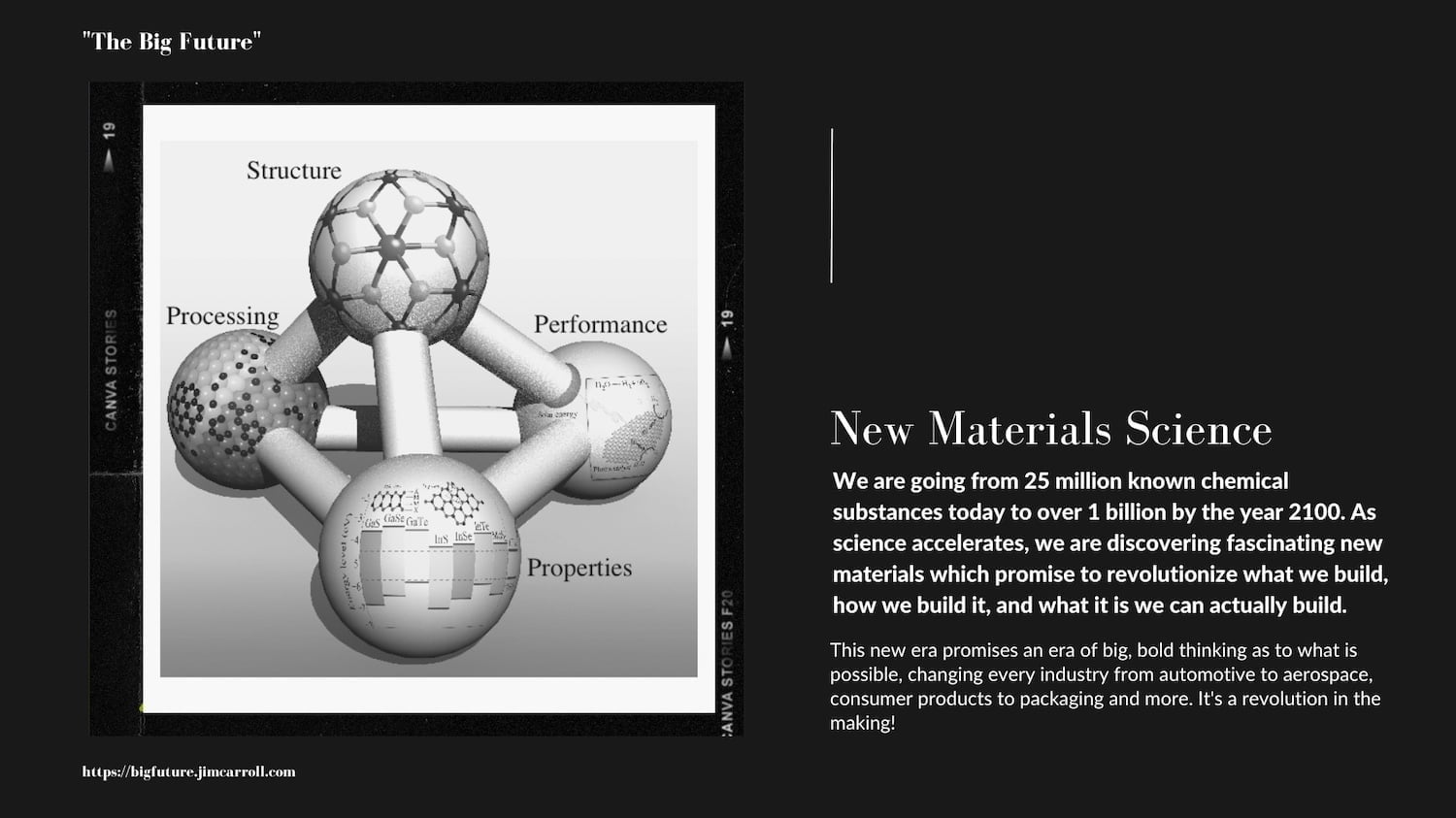“If you weren’t paying attention in chemistry class, you d better start paying attention now!” – Futurist Jim Carroll

Actually, I was really good at chemistry – it was just math. It didn’t really catch my interest though.
My dad was a chemical engineer. He worked hard working with science – first, at a basic chemicals company; then, managing process and engineering at a liquor manufacturing company, and finally being in charge of a major company that manufactured specialty chemicals. Finally, he worked for the environmental management group of a provincial government in Canada.
I will admit that I never really considered the work that he did to be tremendously exciting or important; as a young child, it wasn’t like a lawyer, a doctor, or a banker. Those were exciting professions! And yet today, I look at the world of chemical science to be one of the most exciting – and far-reaching – aspects of our future. That’s because we are going from 25 million known chemical substances today to over 1 billion by the year 2100. As science accelerates, we are discovering fascinating new materials which promise to revolutionize what we build,
how we build it, and what it is we can actually build. This new era promises an era of big, bold thinking as to what is possible, changing every industry from automotive to aerospace, consumer products to packaging, and more. It’s a revolution in the making!
We all use materials. We never really think about it too much though: the science behind their discovery, the acceleration of that science, and what it leads to in terms of new opportunities. That’s what this post is about – and it’s part of my BIG Future series.

Materials? Chemistry? As a futurist, my mind was opened up back in 2004 as I was preparing for a talk for an environmental government ministry. Somewhere during my research, I came across two fascinating observations as to how fast the world of chemical science was evolving.
First, I obtained from a chemical journal on the rapid evolution of knowledge/data in that field:
- to be up-to-date in all areas of chemistry you would currently have to read about 2,000 new publications every day
- if you prefer to screen only the short abstracts, you must read 200 pages per day or about 70,000 pages per year.
- furthermore, since the number of chemistry publications increases also exponentially, you need to double your reading capacity within the next 15 years.
- you must read 20 publications every day in order to grasp only 1% of the overall chemical publications!
I then found a research document that suggested that the result of this rate of advance is a rather exponential increase in the number of known chemical substances:
- “…The number of known chemical substances has been growing exponentially since 1800, from some hundreds then to about 19 million today….”
- “…. the number constantly doubles every 13 years….”
- by 2025: 80 million chemical substances
- by 2050: 300 million
- and by 2100: 5 billion……
19 billion known chemical substances to 5 billion? That’s a pretty exponential change…
Why? Consider this – it was the discovery of a single new chemical substance that led to the opportunity for Apple to miniaturize the hard drive — that led to the first iPod – many years ago. Which was the birth of a multi-billion market.
For every new chemical substance, similar massive new opportunities exist. That’s what it means to live in an exponential world! And that is what it means to focus on future opportunities through innovation.
A Tour of Materials Science
Most of us probably don’t spend much time thinking about ‘stuff.’ It’s all around us.
Materials science research is crucial in many areas, especially in the semiconductor space. The chips that power our electronic devices have got so miniscule that improving their performance and capabilities any further requires expensive specialised equipment and experts with PhDs in materials science to run those machines and conduct experiments.It’s a fascinating process of trial and error, of testing hypotheses and confirming theories,
Indian materials science work is now core to chips worldwide
24 November 2022, The Times of India
But why is it important? Virtually every single industry, new product discovery, and invention is the result of materials science. Our faster discovery of new materials and new science leads us to:
- high performing batteries for next-generation energy storage
- lightweight materials for more efficient and energy-saving transportation
- new electrical and optical material for the continued acceleration of digital technologies
- improving the ability to meet our sustainability goals around energy, climate, and the environment
- the acceleration of biomaterial science, particularly related to the big trend of regenerative medicine explained earlier in this series
- the development of thin solar cells that generate more energy at a lower cost
- healthcare applications such as smart wound dressing not only protect the skin but help to heal it with controlled drug release
- technology that combines the advantages of glass and plastic without the potential disadvantages they may present for use in medical devices such as syringes, vials, blood collection devices, and tubes
The list goes on. Essentially, this aspect of science affects virtually every industry – power and telecommunications, aerospace, construction, biomedical, energy, healthcare, automotive, and sustainable development. Even the acceleration of brain science – in that new materials might help lower the risk of infection for new probes that might be used in brain surgery and the acceleration of computer-to-brain technology (discussed in one of my other BIG Future trends – The Acceleration of Brain Science.)
“These bioactive polymer- based electrodes can enable the conformal contact with irregular tissue and result in low inflammation when compared to conventional rigid inorganic electrodes. In this review, we focus on the use of silk fibroin and cellulose biopolymers as well as certain synthetic polymers to offer the desired flexibility for constructing electrode substrates for a conformal neural interface.
Science – Materials Science; Studies from Donghua University Further Understanding of Materials Science (Bioactive Polymer-enabled Conformal
Neural Interface and Its Application Strategies)
8 February 2023 Biotech Week
The thing is – there are some amazing ideas, fascinating discoveries, and accelerating opportunities coming together. Consider the amazing science of solar cells – what if we could develop “dual-sided solar cells.” What’s that? This!
The idea is as straightforward as it is simple: If I can collect both direct sunlight as well as its reflection via the rear end of my solar cell, this should increase the yield of energy the cell produces. Potential applications are, for instance, building-integrated photovoltaics, agrivoltaics – the simultaneous use of areas of land for both photovoltaic power generation and agriculture – and vertically or high-tilt installed solar modules on high-altitude grounds. Enter the bifacial solar cell. According to the International Technology Roadmap of Photovoltaics, bifacial solar cells could capture a market share of 70% of the overall photovoltaics market by 2030.
Swiss Federal Laboratories for Materials Science and Technology (EMPA); New process boosts efficiency of bifacial CIGS thin film solar cell
23 December 2022, Energy Weekly News
How might this work? Imagine a solar cell on a piece of farmland – the top part is generating energy, and yet the sun goes straight through the cell to provide needed sunshine for the growth of crops. That’s a revolutionary idea and yet, might not be all that far away. The folks involved in this aspect of materials science speak of achieving maximum ‘energy conversion efficiency’ – that’s the ability of the solar cell to generate energy. With this new aspect of science, the highest values achieved so far have been 9.0% for the front side and 7.1% for the rear side, but they want to achieve a goal of 33%. They are already moving towards that!
The cell yielded values of 19.8% for front illumination and 10.9% for rear illumination that had been independently certified by the Fraunhofer Institute for Solar Energy Systems (ISE) in Freiburg/Germany – in the very same cell on a glass substrate. What’s more, the team also succeeded in fabricating, for the very first time, a bifacial CIGS solar cell on a flexible polymer substrate, which – due to their light weight and flexibility – widens the spectrum of potential applications. And finally, the researchers combined two photovoltaic technologies – CIGS and perovskite solar cells – to produce a bifacial “tandem” cell. According to Tiwari, bifacial CIGS technology has the potential to yield energy conversion efficiencies beyond 33%, thus opening up further opportunities for thin film solar cells in the future.
Swiss Federal Laboratories for Materials Science and Technology (EMPA); New process boosts efficiency of bifacial CIGS thin film solar cell
23 December 2022, Energy Weekly News
This is the type of stuff that gets me excited about the future!
Bottom line – materials science matters.
Everything we use is made of a material. The paper (or screen) on which you are reading this article, your clothes, and electrical devices, the building you are in, and even you, are made from different types of materials. We live in a ‘material world’.
Many of us take materials for granted, but each one has been developed and selected to provide the best performance and cost for the job they are used for. Since the Stone Age, humanity has developed materials through the different ages to where we are now in the Molecular Age.
Career in Materials Science and Engineering
15 October 2022, The Hindu Online
And if it is moving faster, the stuff we use in our daily lives will happen faster; new products are discovered faster; potential big challenges are solved faster. What’s critical to understand is that we are now moving into a new era accelerated by the acceleration of science.




GET IN TOUCH
Jim's Facebook page
You'll find Jim's latest videos on Youtube
Mastodon. What's on Jim's mind? Check his feed!
LinkedIn - reach out to Jim for a professional connection!
Flickr! Get inspired! A massive archive of all of Jim's daily inspirational quotes!
Instagram - the home for Jim's motivational mind!